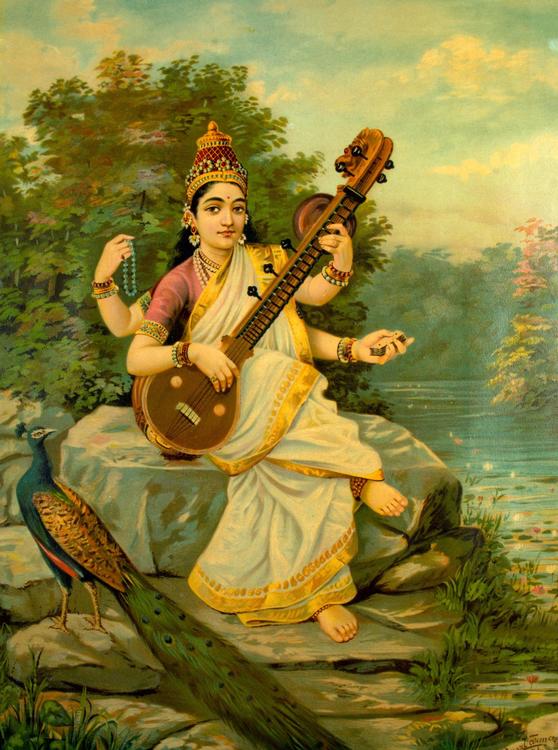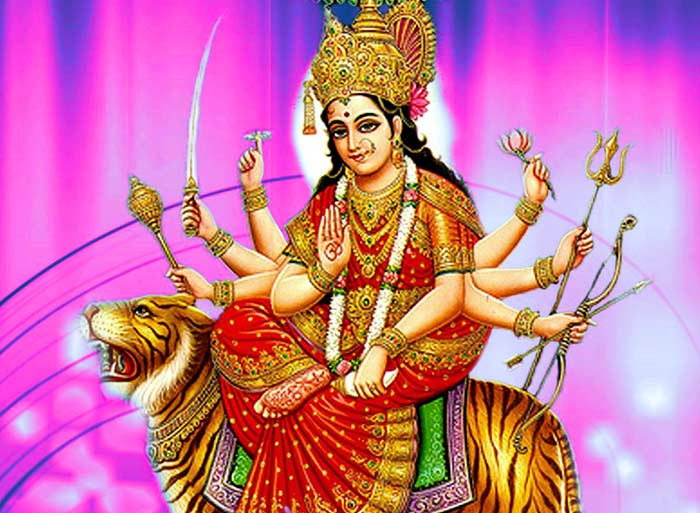Summary | Excerpt | Reviews | Beyond the Book | Read-Alikes | Genres & Themes | Author Bio

This article relates to Djinn Patrol on the Purple Line
While investigating a series of missing children taken from an unnamed Indian slum, Jai and his friends Pari and Faiz, the central protagonists in Djinn Patrol on the Purple Line, come across many pictures and iconography depicting Hindu gods. Here are some brief insights into the mythology surrounding a handful of these deities.
 Vishnu is one of the Hindu triumvirate alongside Brahma and Shiva. Known as the Trimūrti, these three gods are responsible for the creation, upkeep and destruction of the world. Vishnu is the protector of the universe and is said to restore the balance between good and evil. In Vaishnaism, the largest Hindu sect, he is considered to be the greatest god. Vishnu is commonly depicted in religious icons in human form with blue skin. In his four arms he holds a conch, a discus, a lotus flower and a mace. These objects represent many things to Hindus. For example, the conch may represent the primeval sound of creation "om"; the discus may represent the mind (also known as the chakra); the lotus flower is often a symbol of glorious existence and creation; and the mace may represent mental and physical strength. Vishnu has been incarnated nine times, but Hindus believe he will return a final time at the end of this world. Krishna is Vishnu's eighth avatar and is considered to be a supreme god in his own right.
Vishnu is one of the Hindu triumvirate alongside Brahma and Shiva. Known as the Trimūrti, these three gods are responsible for the creation, upkeep and destruction of the world. Vishnu is the protector of the universe and is said to restore the balance between good and evil. In Vaishnaism, the largest Hindu sect, he is considered to be the greatest god. Vishnu is commonly depicted in religious icons in human form with blue skin. In his four arms he holds a conch, a discus, a lotus flower and a mace. These objects represent many things to Hindus. For example, the conch may represent the primeval sound of creation "om"; the discus may represent the mind (also known as the chakra); the lotus flower is often a symbol of glorious existence and creation; and the mace may represent mental and physical strength. Vishnu has been incarnated nine times, but Hindus believe he will return a final time at the end of this world. Krishna is Vishnu's eighth avatar and is considered to be a supreme god in his own right.
 Saraswati is a Hindu goddess associated with knowledge, music and art. Like Vishnu, she also forms part of a trinity, called the Tridevi, alongside Lakshmi and Parvati. This female trinity assists the Trimūrti in creating, maintaining and regenerating the universe. Saraswati is often depicted as a beautiful woman dressed in pure white seated on a white lotus. Sometimes she is shown to have four arms, other times just two. She is also commonly shown to be playing a musical instrument known as a veena, which represents the harmony of expressing knowledge through the creative arts and sciences. Other symbolism associated with Saraswati includes the hamsa or swan, a sacred bird, which if offered a mixture of milk and water, is said to be able to drink the milk alone—a metaphor for the bird's ability to easily distinguish between good and evil. Saraswati is the consort of Brahma. Their union bore a son, Manu, who some Hindus believe to have been the first man and therefore the father of all mankind.
Saraswati is a Hindu goddess associated with knowledge, music and art. Like Vishnu, she also forms part of a trinity, called the Tridevi, alongside Lakshmi and Parvati. This female trinity assists the Trimūrti in creating, maintaining and regenerating the universe. Saraswati is often depicted as a beautiful woman dressed in pure white seated on a white lotus. Sometimes she is shown to have four arms, other times just two. She is also commonly shown to be playing a musical instrument known as a veena, which represents the harmony of expressing knowledge through the creative arts and sciences. Other symbolism associated with Saraswati includes the hamsa or swan, a sacred bird, which if offered a mixture of milk and water, is said to be able to drink the milk alone—a metaphor for the bird's ability to easily distinguish between good and evil. Saraswati is the consort of Brahma. Their union bore a son, Manu, who some Hindus believe to have been the first man and therefore the father of all mankind.
 Durga Maa is a goddess of war and the warrior form of Parvati (who is the goddess of fertility and love). She is often depicted riding a tiger or lion and possesses as many as 18 arms, each holding a significant weapon of destruction and creation. Legend says that Durga was created by the Trimūrti to slay the buffalo demon Mahisasura, who was gifted with the power of invincibility. Embodying the collective energy of Brahma, Vishnu and Shiva, Durga set out for battle against Mahisasura and vanquished him. A lot of Hindu iconography depicts Durga during this legendary battle. Of note is her face, which remains tranquil and serene, a sign that the goddess is not acting out of violence but out of a sense of duty and necessity, for the greater good of the universe. The popular Durga-puja festival is held in her honor every year in West Bengal.
Durga Maa is a goddess of war and the warrior form of Parvati (who is the goddess of fertility and love). She is often depicted riding a tiger or lion and possesses as many as 18 arms, each holding a significant weapon of destruction and creation. Legend says that Durga was created by the Trimūrti to slay the buffalo demon Mahisasura, who was gifted with the power of invincibility. Embodying the collective energy of Brahma, Vishnu and Shiva, Durga set out for battle against Mahisasura and vanquished him. A lot of Hindu iconography depicts Durga during this legendary battle. Of note is her face, which remains tranquil and serene, a sign that the goddess is not acting out of violence but out of a sense of duty and necessity, for the greater good of the universe. The popular Durga-puja festival is held in her honor every year in West Bengal.
Hindu gods are generally depicted with multiple arms to visually represent their supreme powers and superiority over humankind. For example, Durga's arms holding multiple weapons represent her immense power to combat evil forces; while the objects Vishnu holds in his hands are generally symbols of different spheres of human/spiritual life over which he rules.
Vishnu Surrounded by his Avatars by Raja Ravi Varma
Saraswati by Raja Ravi Varma
Durga Maa, courtesy of Hindu Gallery
Filed under Places, Cultures & Identities
![]() This "beyond the book article" relates to Djinn Patrol on the Purple Line. It originally ran in March 2020 and has been updated for the
May 2021 paperback edition.
Go to magazine.
This "beyond the book article" relates to Djinn Patrol on the Purple Line. It originally ran in March 2020 and has been updated for the
May 2021 paperback edition.
Go to magazine.
Your guide toexceptional books
BookBrowse seeks out and recommends the best in contemporary fiction and nonfiction—books that not only engage and entertain but also deepen our understanding of ourselves and the world around us.